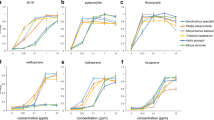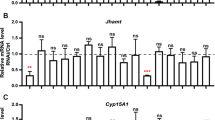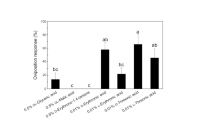Abstract
Diterpene resin acids (DRAs) are important components of oleoresin and greatly contribute to the defense strategies of conifers against herbivorous insects. In the present study, we determined that DRAs function as insect juvenile hormone (JH) antagonists that interfere with the juvenile hormone-mediated binding of the JH receptor Methoprene-tolerant (Met) and steroid receptor coactivator (SRC). Using a yeast two-hybrid system transformed with Met and SRC from the Indian meal moth Plodia interpunctella, we tested the interfering activity of 3704 plant extracts against JH III-mediated Met-SRC binding. Plant extracts from conifers, especially members of the Pinaceae, exhibited strong interfering activity, and four active interfering DRAs (7α-dehydroabietic acid, 7-oxodehydroabietic acid, dehydroabietic acid, and sandaracopimaric acid) were isolated from roots of the Japanese pine Pinus densiflora. The four isolated DRAs, along with abietic acid, disrupted the juvenile hormone-mediated binding of P. interpunctella Met and SRC, although only 7-oxodehydroabietic acid disrupted larval development. These results demonstrate that DRAs may play a defensive role against herbivorous insects via insect endocrine-disrupting activity.



Similar content being viewed by others
References
Ashok M, Turner C, Wilson TG (1998) Insect juvenile hormone resistance gene homology with the bHLH-PAS family of transcriptional regulators. Proc Natl Acad Sci U S A 95:2761–2766
Erbilgin N, Krokene P, Christiansen E, Zeneli G, Gershenzon J (2006) Exogenous application of methyl jasmonate elicits defenses in Norway spruce (Picea abies) and reduces host colonization by the bark beetle Ips typographus. Oecologia 148:426–436
Grabherr MG, Haas BJ, Yassour M, Levin JZ, Thompson DA, Amit I, Adiconis X, Fan L, Raychowdhury R, Zeng Q et al (2011) Full-length transcriptome assembly from RNA-seq data without a reference genome. Nat Biotechnol 29:644–652
Jindra M, Palli SR, Riddiford LM (2013) The juvenile hormone signaling pathway in insect development. Annu Rev Entomol 58:181–204
Kayukawa T, Minakuchi C, Namiki T, Togawa T, Yoshiyama M, Kamimura M, Mita K, Imanishi S, Kiuchi M, Ishikawa Y et al (2012) Transcriptional regulation of juvenile hormone-mediated induction of Krüppel homolog 1, a repressor of insect metamorphosis. Proc Natl Acad Sci U S A 109:11729–11734
Keeling CI, Bohlmann J (2006) Diterpene resin acids in conifers. Phytochemistry 67:2415–2423
Kewley RJ, Whitelaw ML, Chapman-Smith A (2004) The mammalian basic helix–loop–helix/PAS family of transcriptional regulators. Int J Biochem Cell B 36:189–204
Kopper BJ, Illman BL, Kersten PJ, Klepzig KD, Raffa KF (2005) Effects of diterpene acids on components of a conifer bark beetle fungal interaction: tolerance by Ips pini and sensitivity by its associate Ophiostoma ips. Environ Entomol 34:486–493
Lee S-H, Oh H-W, Fang Y, An S-B, Park D-S, Song H-H, Oh S-R, Kim S-Y, Kim S, Kim N et al (2015) Identification of plant compounds that disrupt the insect juvenile hormone receptor complex. Proc Natl Acad Sci U S A 112:1733–1738
Li M, Mead EA, Zhu J (2011) Heterodimer of two bHLH-PAS proteins mediates juvenile hormone-induced gene expression. Proc Natl Acad Sci U S A 108:638–643
Phillips MA, Croteau RB (1999) Resin-based defenses in conifers. Trends Plant Sci 4:184–190
Powell JS, Raffa KF (1999) Effects of selected Larix laricina terpenoids on Lymantria dispar (Lepidoptera: Lymantriidae) development and behaviour. Environ Entomol 28:148–154
Powell JS, Raffa KF (2003) Fate of conifer terpenes in a polyphagous folivore: evidence for metabolism by gypsy moth (Lepidoptera: Lymantriidae). J Entomol Sci 38:583–601
Rees D (2004) Insects of stored products. CSIRO Publishing, Collingwood
Regnault-Roger C, Vincent C, Arnason JT (2012) Essential oils in insect control: low-risk products in a high-stakes world. Annu Rev Entomol 57:405–424
Robert JA, Madilao LL, White R, Yanchuk A, King J, Bohlmann J (2010) Terpenoid metabolite profiling in Sitka spruce identifies association of dehydroabietic acid, (+)-3-carene and terpinolene with resistance against white pine weevil. Botany 88:810–820
Shin SW, Zou Z, Saha TT, Raikhel AS (2012) bHLH-PAS heterodimer of methoprene-tolerant and cycle mediates circadian expression of juvenile hormone-induced mosquito genes. Proc Natl Acad Sci U S A 109:16576–16581
Sláma K (1971) Insect juvenile hormone analogues. Annu Rev Biochem 40:1079–1102
Trapp S, Croteau R (2001) Defensive resin biosynthesis in conifers. Annu Rev Plant Physiol Plant Mol Biol 52:689–724
Wagner MR, Benjamin DM, Clancy KM, Schuh BA (1983) Influence of diterpene resin acids on feeding and growth of larch sawfly, Pristiphora erichsonii (Hartig). J Chem Ecol 9:119–127
Waldbauer GP (1968) The consumption and utilization of food by insects. Advan Insect Physiol 5:229–288
Wilson TG, Ashok M (1998) Insecticide resistance resulting from an absence of target-site gene product. Proc Natl Acad Sci U S A 95:14040–14044
Zhang Z, Xu J, Sheng Z, Sui Y, Palli SR (2011) Steroid receptor co-activator is required for juvenile hormone signal transduction through a bHLH-PAS transcription factor, methoprene tolerant. J Biol Chem 286:8437–8447
Acknowledgements
This work was supported by a grant from the National Institute of Forest Science (Project No. FE0702-2016-02-2016 “Development of environment-friendly control agents against pine wilt disease based on BT”) and KRIBB Research Initiative Program (KGM4981612), awarded to H.O., and the National Research Foundation of Korea Grant (NRF-2008-2004725), awarded to D.P
Author information
Authors and Affiliations
Corresponding authors
Ethics declarations
Conflict of Interest
The authors declare no competing financial interests.
Electronic supplementary material
ESM 1
(PDF 4.76 mb)
Rights and permissions
About this article
Cite this article
Oh, HW., Yun, CS., Jeon, J.H. et al. Conifer Diterpene Resin Acids Disrupt Juvenile Hormone-Mediated Endocrine Regulation in the Indian Meal Moth Plodia interpunctella . J Chem Ecol 43, 703–711 (2017). https://doi.org/10.1007/s10886-017-0861-9
Received:
Revised:
Accepted:
Published:
Issue Date:
DOI: https://doi.org/10.1007/s10886-017-0861-9




